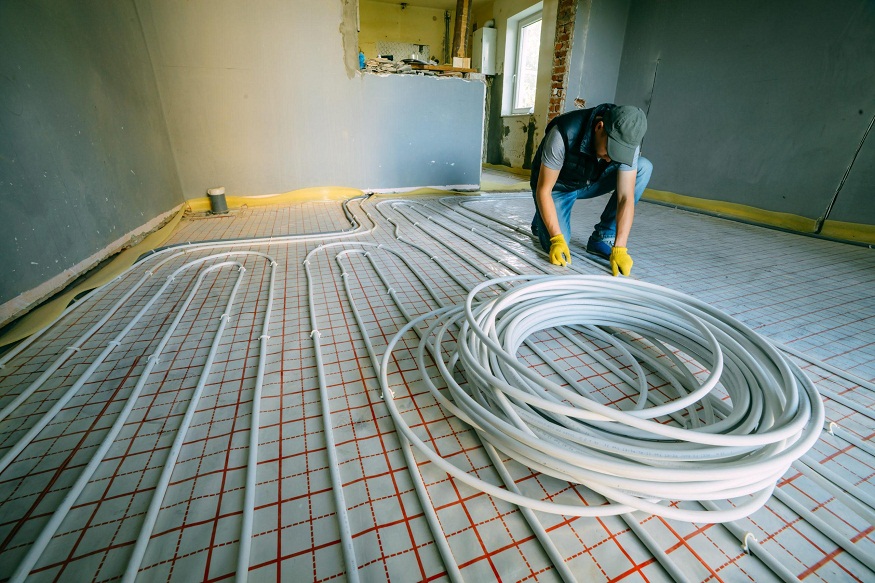Underfloor heating kits provide you with efficient warmth and comfort, perfect for any space. You can choose between electric systems for smaller areas or water-based systems for larger ones. These systems not only offer even heat distribution but also free up valuable wall space. The installation process requires accuracy, and maintaining your system can help avoid costly repairs. Discover more about the benefits, installation tips, and cost considerations to make an informed choice for your home.
Types of Underfloor Heating Kits
When you’re considering electricunderfloor heating kits, it’s crucial to know the different types available to find the perfect fit for your space.
You’ll typically encounter two main types: electric and water-based systems. Electric systems use heating cables or mats, making them easy to install and ideal for smaller areas.
On the other hand, water-based systems circulate warm water through pipes, providing efficient heating for larger spaces.
Each type has its own installation requirements and energy consumption levels, so evaluate your needs and preferences carefully.
Choosing the right system guarantees you’ll enjoy comfortable warmth in your home.
Benefits of Underfloor Heating
It’s known that electric underfloor heating offers numerous benefits that can enhance your home’s comfort and efficiency.
First, it provides even heat distribution, eliminating cold spots and creating a cozy atmosphere.
You’ll enjoy improved energy efficiency since it operates at lower temperatures compared to traditional heating systems, saving you money on energy bills.
Plus, underfloor heating frees up wall space, allowing for more design flexibility without radiators cluttering your rooms.
It’s also compatible with various flooring types, making it versatile for any home.
Finally, you’ll appreciate the luxurious feeling of warm floors, especially during chilly mornings.
Experience the comfort and convenience of underfloor heating today!
Installation Process and Tips
Although installing underfloor heating might seem intimidating, it can be a rewarding DIY project if you approach it with the right preparation and knowledge.
Start by measuring your space accurately and gathering all necessary tools and materials. Clear the area and make sure your subfloor is clean and dry.
Follow the manufacturer’s instructions closely for laying out the heating elements. Remember to leave space for expansion and avoid overlapping cables.
Once installed, connect the system to your thermostat and test it before covering with flooring.
Finally, don’t rush—taking your time guarantees a successful installation and long-lasting performance.
Maintenance of Underfloor Heating Systems
To guarantee your underfloor heating system operates efficiently and lasts for years, regular maintenance is essential.
Start by checking the system for any leaks or air trapped in the pipes; bleeding the system can help. Keep an eye on the thermostat calibration to maintain accurate temperature control.
It’s also wise to inspect the wiring and connections periodically, guaranteeing everything’s secure and functioning. Clean the floor surface regularly, avoiding abrasive materials that could damage the heating elements.
Finally, consider scheduling a professional inspection annually to catch potential issues early and keep your system in top condition.
Cost Considerations and Energy Efficiency
Maintaining your underfloor heating system not only guarantees its longevity but also impacts your overall costs and energy efficiency.
Regular checks can help identify issues early, preventing costly repairs down the line. By keeping your system in top shape, you’ll enjoy lower energy bills since underfloor heating operates more efficiently than traditional radiators.
Insulation plays a key role too; good insulation reduces heat loss, maximizing your system’s performance.
When considering installation costs, factor in long-term savings on energy and maintenance.
Ultimately, investing wisely in your underfloor heating can lead to significant savings while guaranteeing a comfortable home.
Frequently Asked Questions
Can Underfloor Heating Be Installed in Existing Homes?
Yes, you can install electric under floor heating in existing homes.
It’s often easier than you think, especially with options like electric systems.
Just make certain you have enough space and consider your flooring type for best results.
What Flooring Types Are Compatible With Underfloor Heating?
You can use various flooring types with underfloor heating, including tiles, laminate, engineered wood, and some vinyls.
Just confirm the material has good thermal conductivity to maximize efficiency and warmth in your home.
How Long Does Underfloor Heating Take to Warm Up?
Underfloor heating typically takes about 30 minutes to an hour to warm up, depending on the system and flooring type.
You’ll enjoy a cozy room once it’s fully heated, so be patient!
Are There Any Safety Concerns With Underfloor Heating Systems?
Yes, there are safety concerns with underfloor heating systems.
You should guarantee proper installation, avoid overheating, and use appropriate insulation.
Regular maintenance and adhering to manufacturer guidelines can help mitigate potential risks and guarantee safe operation.
Can I Control Underfloor Heating With a Smart Thermostat?
Yes, you can control underfloor heating with a smart thermostat.
It allows you to adjust temperatures remotely and schedule heating times, ensuring comfort and energy efficiency in your home, all at your fingertips.
Finally
In conclusion, underfloor heating kits offer a comfortable and energy-efficient solution for your home. By understanding the types available and their benefits, you can make an informed choice that suits your needs. With the right installation and maintenance, these systems can provide warmth for years to come. Plus, considering the cost and energy savings, it’s a smart investment. So, why not explore your options and enjoy the cozy comfort of underfloor heating?

